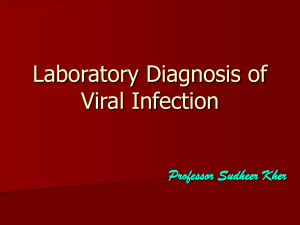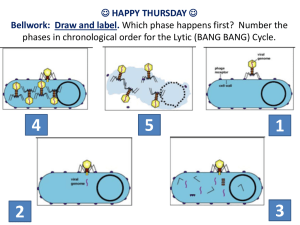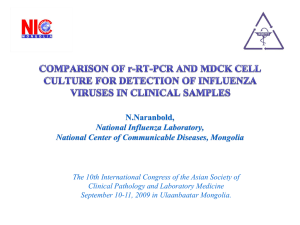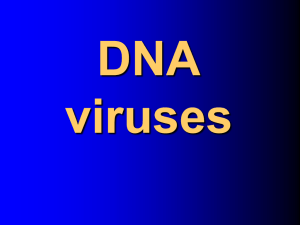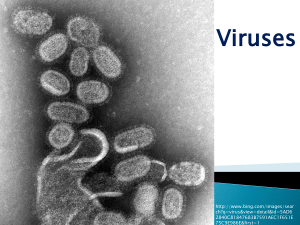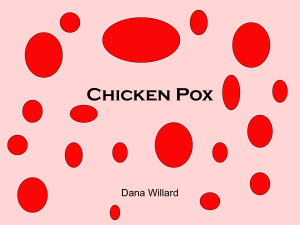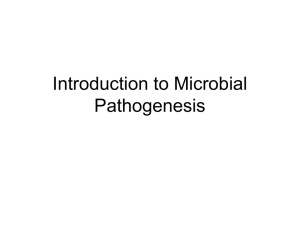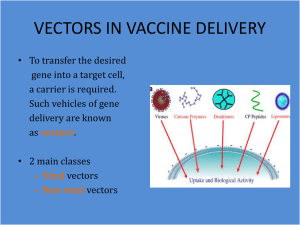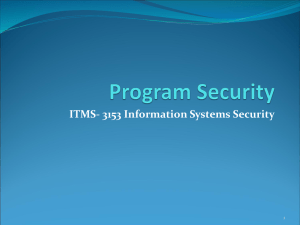Viral Infection Lab Diagnosis
advertisement
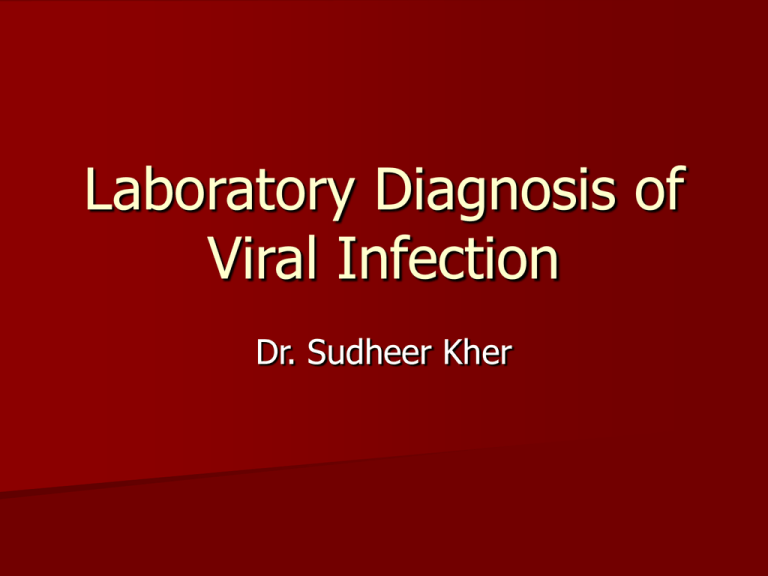
Laboratory Diagnosis of Viral Infection Dr. Sudheer Kher ATTACHMENT Click after each step to view process PENETRATION UNCOATING HOST FUNCTIONS Transcription Translation VIRAL LIFE CYCLE REPLICATION ASSEMBLY (MATURATION) RELEASE MULTIPLICATION Difficulties Can not be seen under light microscope Can not be cultivated easily Do not grow on culture media Treatment was not available Changed situation Rapid techniques Screening for Blood transfusion Treatment available Microscopy Electron Microscope Light microscope – Inclusion bodies Fluorescent Microscope -Fluorescent antibody technique Demonstration of Viral Antigens Precipitation on gel eg HBsAg Immunofluorescence Counter Immuno Electro Phoresis (CIEP) Enzyme Linkes Immuno Sorbant Assay (ELISA) Isolation of Virus Laboratory animals Fertilized Hen’s Egg – Chorioallantoic membrane – Allantoic cavity – Amniotic cavity – Yolk sac Organ/Tissue/Cell Culture Growth identified by serological method like neutralization. Serological Reactions Rising titre of antibody in paired sample of sera – First sample – At the earliest – Second sample – After 2 weeks Single sample IgM type of antibody detection Techniques – Neutralization, ELISA, CFT, Haemagglutination Inhibition (HAI)Test Specimens According to the disease – Respiratory – Throat swab – CNS – CSF – Eyes- Conjunctival scrapings – Liver – Blood – PUO – Blood – Skin - Scrapings Viral Hemagglutination Hemagglutination – Originally seen with the Influenza virus by Hirst in 1941. – A convenient method of detection & assay of Influenza virus. – Due to the presence of Hemagglutinin spikes on the surface. Reversal of hemagglutination – Elution – Due to the presence of Neuraminidase enzyme, Receptor Destroying Enzyme (RDE) – Destruction of receptor – reversal of hemagglutination – release of virus from the red cell surface – Found only in Myxoviuses. Virus Culture Embryonated Egg Chorioallantioc membrane (CAM) Allantoic cavity Amniotic cavity Yolk Sac Cell Lines/ Tissue cultures Primary Diploid/ Secondary Continuous Animal inoculation Suckling mice Embryonated Hen’s Egg Chorioallantoic membrane (CAM) – visible lesions called pocks. Each infectious virus particle forms one pock. e.g. Variola, Vaccinia virus Allantoic cavity – Influenza virus (vaccine production) & paramyxoviruses Amniotic cavity – primary isolation of Influenza virus Yolk sac – Chlmyadia, Rickettsiae & some viruses Embryonated Hen’s Egg Cell Culture Routinely used for growing viruses Classified into 3 types: – Primary cell culture – normal cells freshly taken from body & cultured, limited growth 1. Rhesus monkey kidney 2. Chick embryo fibroblast 3. Human amnion cell culture – Diploid cell strains – cells of single type (fibroblast cells) that can be subcultivated for limited number of times, mostly 50 1. WI-38: human embryonic lung cell 2. HL-8: Rhesus embryo cell – Continuous cell lines – malignant cells, indefinite subcultivtion 1. 2. 3. 4. HeLa: Human Ca of cervix cell line HEP-2: Human epithelioma of larynx Vero: Vervet monkey kidney McCoy, Detroit-6, BHK-21, Kb Cell Culture Tissues Individual cells trypsin & mechanical shaking Cells are washed, counted & suspended in a growth medium. Growth medium – Minimum Essential Medium (MEM): essential aminoacids, vitamins, salts, glucose & bicarbonate in 5% CO2 with 5% fetal calf or calf serum, antibiotics & phenol red indicator Cell Culture Bottles / Tubes Detection of virus growth in cell cultures 1. Cytopathic effects (CPE) – morphological changes in cultured cells, seen under microscope, characteristic CPE for different groups of viruses 2. Metabolic Inhibition – no acid production in presence of virus 3. Hemadsorption – influenza & parainfluenza viruses, by adding guinea pig erythrocytes to the culture Detection of virus growth in cell cultures 4. Interference – growth of a non cytopathogenic virus can be tested by inoculating a known cytopathogenic virus: growth of first virus will inhibit the infection by second 5. Transformation – oncogenic viruses induce transformation & loss of contact inhibition – microtumors 6. Immunofluorescence – test for viral Ag in cells from viral infected cultures.
